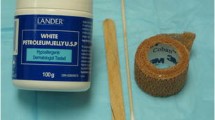Abstract
Background
Fingertip injuries are common in the pediatric population. Composite grafting is a frequently used technique for distal amputations in children given the reported success rate. We sought to study the early clinical results of composite grafting for fingertip injuries in the pediatric population.
Methods
A retrospective review was performed over a 5-year period at a tertiary care pediatric hospital to identify those patients who underwent composite grafting of fingertip injuries. Patients were included if they were 18 years old or younger and sustained an injury distal to the distal interphalangeal joint (or thumb interphalangeal joint). Demographic information was recorded. Graft viability was characterized as no take, partial take, or complete take. The number of secondary procedures and number and duration of follow-up appointments were recorded. Hypothesis testing was done using ordinal logistic regression analysis.
Results
Thirty-nine patients underwent fingertip composite grafting. The mean age was 5.9 years (1–18 years); there were 24 males (61.5 %) and 15 females (38.5 %). Thirteen patients had no graft take (33.3 %), 23 patients had partial take (59.0 %), and three patients had complete take (7.7 %). Only four patients underwent secondary revision (10 %). The median number of follow-up appointments was 3 and the average follow-up time was 4.5 months. Age did not appear to have a statistically significant influence on graft take.
Conclusions
Fingertip composite grafts rarely take completely even in young children. Despite poor viability, however, most patients will have at least partial graft take and do not undergo additional reconstructive procedures.



Similar content being viewed by others
References
Aden KK, Biel MA. The evaluation of pharmacologic agents on composite graft survival. Arch Otolaryngol Head Neck Surg. 1992;118:175–8.
Brent B. Replantation of amputated distal phalangeal parts of fingers without vascular anastomoses, using subcutaneous pockets. Plast Reconstr Surg. 1979;63:1–8.
Douglas B. Successful replacement of completely avulsed portions of fingers as composite grafts. Plas Reconstr Surg Transplant Bull. 1959;23:213–25.
Elsahy NI. When to replant a fingertip after its complete amputation. Plast Reconstr Surg. 1977;60:11–21.
Fassler PR. Fingertip injuries: evaluation and treatment. J Am Acad Orthop Surg. 1996;4:84–92.
Fetter-Zarzeka A, Joseph MM. Hand and fingertip injuries in children. Pediatr Emerg Care. 2002;18:341–5.
Foucher G, Citron N. Therapeutic approach in fingertip injuries. Skin cover in the injured hand. Edinburgh: Churchill Livingstone; 1992. 182.
Gellman H. Fingertip-nail bed injuries in children: current concepts and controversies of treatment. J Craniofac Surg. 2009;20:1033–5.
Gillies H, Reid DA. Autograft of the amputated digit. Br J Plast Surg. 1955;7:338–42.
Hartman DF, Goode RL. Pharmacologic enhancement of composite graft survival. Arch Otolaryngol Head Neck Surg. 1987;113:720–3.
Hattori Y, Doi K, Ikeda K, et al. A retrospective study of functional outcomes after successful replantation versus amputation closure for single fingertip amputations. J Hand Surg. 2006;31:811–8.
Heistein JB, Cook PA. Factors affecting composite graft survival in digital tip amputations. Ann Plast Surg. 2003;50:299–303.
Hirase Y. Postoperative cooling enhances composite graft survival in nasal-alar and fingertip reconstruction. Br J Plast Surg. 1993;46:707–11.
Hong JP, Lee SJ, Lee HB, et al. Reconstruction of fingertip and stump using a composite graft from the hypothenar region. Ann Plast Surg. 2003;51:57–62.
Lee PK, Ahn ST, Lim P. Replantation of fingertip amputation by using the pocket principle in adults. Plast Reconstr Surg. 1999;103:1428–35.
Lemmon JA, Janis JE, Rohrich RJ. Soft-tissue injuries of the fingertip: methods of evaluation and treatment. An algorithmic approach. Plast Reconstr Surg. 2008;122:105e–17.
Li EN, Menon NG, Rodriguez ED, et al. The effect of hyperbaric oxygen therapy on composite graft survival. Ann Plast Surg. 2004;53:141–5.
Martin, C., Gonzalez del Pino, J. Controversies in the treatment of fingertip amputations. Conservative versus surgical reconstruction. Clinical orthopaedics and related research: 63–73, 1998.
Moiemen NS, Elliot D. Composite graft replacement of digital tips. 2. A study in children. J Hand Surg (Br). 1997;22:346–52.
Murai M, Lau HK, Pereira BP, et al. A cadaver study on volume and surface area of the fingertip. J Hand Surg. 1997;22:935–41.
Ogo K. Does the nail bed really regenerate? Plast Reconstr Surg. 1987;80:445–7.
Rose EH, Norris MS, Kowalski TA, et al. The “cap” technique: nonmicrosurgical reattachment of fingertip amputations. J Hand Surg. 1989;14:513–8.
Son D, Han K, Chang DW. Extending the limits of fingertip composite grafting with moist-exposed dressing. Int Wound J. 2005;2:315–21.
Yeo CJ, Sebastin SJ, Chong AK. Fingertip injuries. Singap Med J. 2010;51:78–86. quiz 87.
Conflict of Interest
Kyle R. Eberlin declares that he has no conflict of interest.
Kathleen Busa declares that she has no conflict of interest.
Donald S. Bae declares that he has no conflict of interest.
Peter M. Waters declares that he has no conflict of interest.
Brian I. Labow declares that he has no conflict of interest.
Amir H. Taghinia declares that he has no conflict of interest.
Statement of Human and Animal Rights
The authors certify that all institutional and national guidelines for the care and use of laboratory animals were followed in this study.
Statement of Informed Consent
Informed consent was obtained for the procedures performed in this study, although patient identifying information has been omitted from the manuscript.
Disclosures
None of the authors has any financial interest in any of the products, devices, or drugs mentioned in this manuscript, or any other conflict of interest to disclose.
Level of Evidence
Clinical Question: Therapeutic
Level of Evidence: IV
Author information
Authors and Affiliations
Corresponding author
About this article
Cite this article
Eberlin, K.R., Busa, K., Bae, D.S. et al. Composite grafting for pediatric fingertip injuries. HAND 10, 28–33 (2015). https://doi.org/10.1007/s11552-014-9671-5
Published:
Issue Date:
DOI: https://doi.org/10.1007/s11552-014-9671-5




